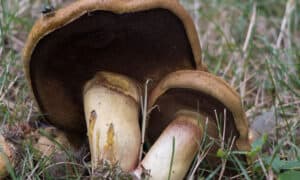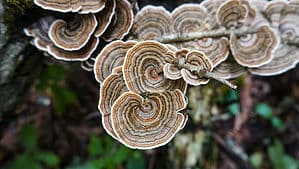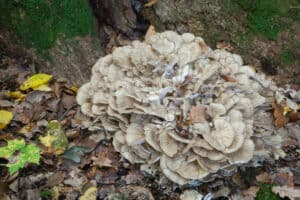From soft, peachy shades to orange-red shades and vivid neon hues, orange mushrooms are a feast for the eyes. You can find this color represented across a range of mushroom families from large cap and stem (aka pileus and stipe) mushrooms to bracket and cup fungi. Some are edible, some quite toxic, and all are beautiful parts of various ecosystems.
In this guide, we’ll cover three species of orange mushrooms, their classifications, native ranges, ecology, characteristics, and more.
Alright, let’s get to it!
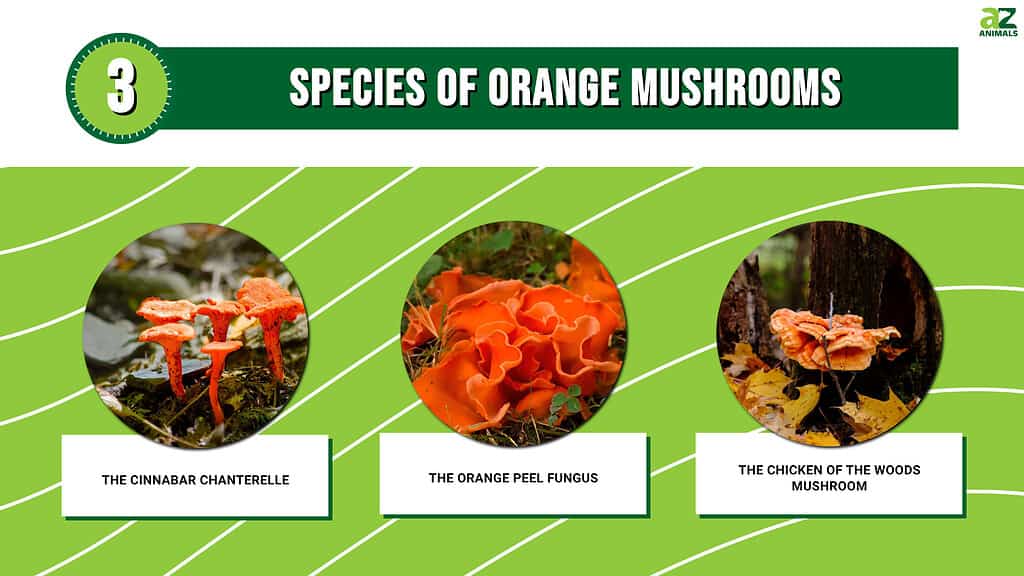
3 Species of Orange Mushrooms
If you go out foraging for mushrooms in any season, you very well may come across orange mushrooms tucked away in leaf litter, flushing across the forest floor, or boldly covering decomposing logs. The often bright shades of orange mushrooms can stand out in any season, and they tend to capture our attention with their vivid beauty.
Below, we’ll talk about three unique species of orange mushrooms. All three of these species are edible. If you want to forage for them but are new at mushroom hunting, the absolute best practice is to accompany a mushroom expert on a foraging trip.
You should also be able to identify and distinguish between any poisonous look-alikes that occur in your local region. When in doubt about the identity of a species, it’s always the best bet to not consume a wild mushroom.
Read on to find out more!
1. Cinnabar Chanterelle (Cantharellus cinnabarinus)
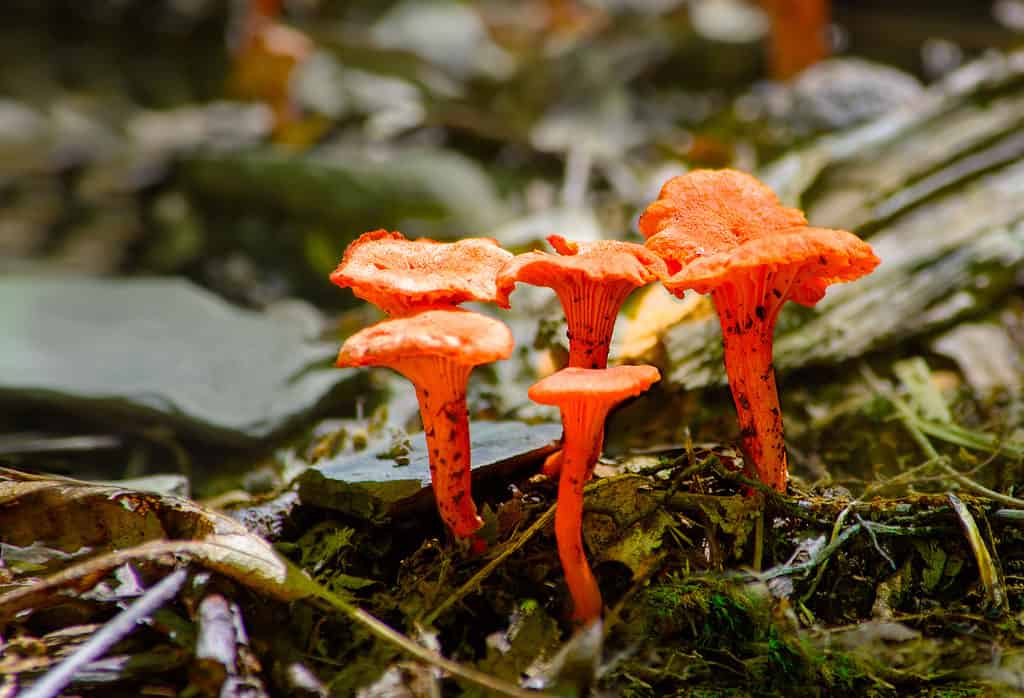
The cinnabar chanterelle is edible, with many praising its apricot-like, nutty, and slightly floral flavor.
©K Quinn Ferris/Shutterstock.com
When someone mentions chanterelles, and if you’re vaguely familiar with them, you may picture the golden chanterelle, Cantherellus cibarius. But this is simply one of many chanterelle species in the Cantharellaceae family, and, if you live in North America, you may be surprised to learn that Cantherellus cibarius is native to Europe and doesn’t actually occur here. Instead, we have a number of other chanterelle species, including cibarius-like species that closely resemble the morphology and flavor profile of C. cibarius.
One lovely species that occurs in North America is the cinnabar chanterelle, Chantharellus cinnabarinus. This mushroom produces various shades of orange-red and orange-pink that tend to distinguish it from the more golden chanterelles.
Edibility
Like all chanterelles currently identified, the cinnabar chanterelle is edible, with many people praising its apricot-like, nutty, and slightly floral flavor. This species also has a bit of a peppery end note that is rather delightful in many dishes. Chanterelles are excellent prepared in a number of ways, including sauteing with garlic, butter, and sage.
Research on Potential Medicinal Applications or Properties
You may also be wondering if the cinnabar chanterelle has any medicinal properties. This chanterelle is not well studied in terms of potential medicinal compounds. However, one study demonstrates that C. cinnabarinus contains a notably high antioxidant concentration. Most (of the few) medicinal studies of this genus, however, tend to focus on C. cibarius (the golden chanterelle).
Distribution and Ecology
Occurring in eastern North America’s hardwood forests, this species of chanterelle is especially mycorrhizal with beech and oak trees. You can also find it growing among hickories and aspens. They can appear singularly or in scattered flushes during the summer and fall. As a mycorrhizal mushroom, Cantharellus cinnabarinus develops a mutually beneficial plant-fungi relationship with its host trees. In this partnership, the mycelium of the cinnabar chanterelle delivers essential nutrients like phosphorus and nitrogen to the roots of its host tree, such as beech or oak, in exchange for sugars and other metabolites from the roots of the tree.
To Identify
C. cinnabarinus, like all chanterelles, features a cap and stipe fruiting body. This species is rather small compared to many other chanterelles.
Its cap is typically only .4-1.5 inches across, and is convex when young, expanding to flat or shallowly depressed in the center at maturity. As it ages, the margins of the cap can become quite wavy and it can take on a bit more of a funnel shape.
Prominent, uncrowded false gills, or ridges, run down the stipe. These gills are typically either the same color as the cap or slightly paler. To distinguish false gills from true gills, run your thumb across them. With true gills, you can easily separate each gill, which should be moveable and delicate. You can usually easily remove them from the underside of the cap. False gills, which are a primitive form of true gills, are closer to folds or ridges on the mushroom. When you run your thumb across them, you won’t be able to separate and move them and you shouldn’t be able to easily remove them from the rest of the mushroom.
The stipe can range from .4-1.5 inches tall and up to .4 inches wide. When young, the stipe is typically an equal width from top to bottom. But as the mushroom ages, you’ll often find that the stipe tapers to the base. The color should be similar to the cap or a bit paler.
The flesh of the cinnabar chanterelle is solid, unchanging when cut, and whitish to a pale shade of the cap color. People often describe the aroma of this mushroom as reminiscent of apricots. The spore print is off-white to very pale pink.
Recent studies show that there may be a few pretty much identical species in the U.S., but luckily all are edible. If you’d like to know more about these species, look into Cantharellus coccolobae, Cantharellus corallinus and similar species.
2. Orange Peel Fungus (Aleuria aurantia)
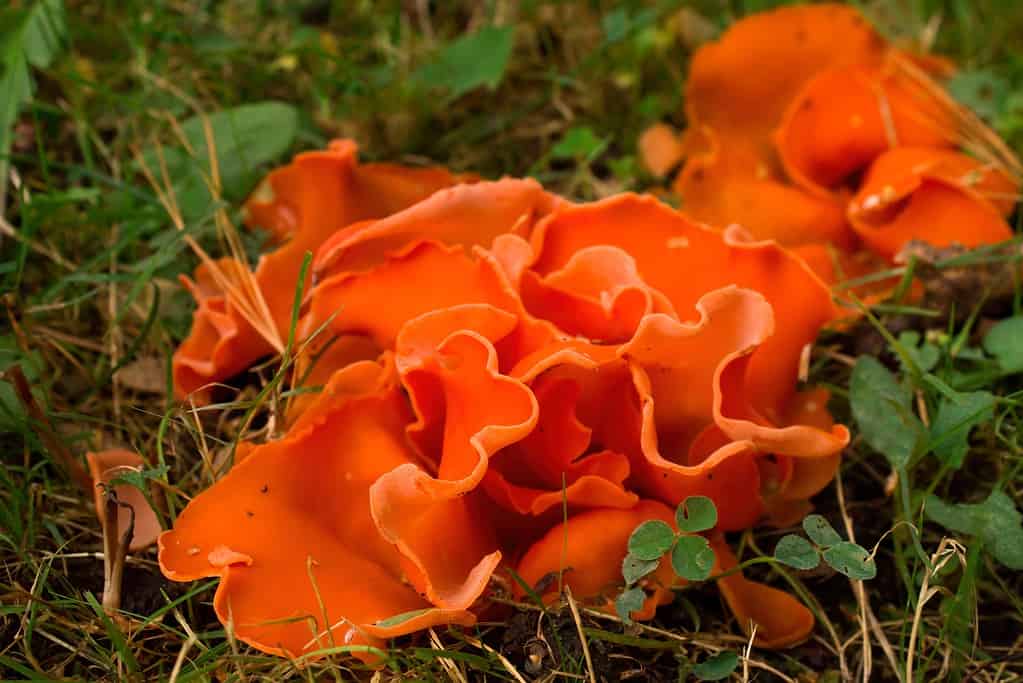
A wonderfully whimsical mushroom to come across, the orange peel fungus (Aleuria aurantia) is a bright orange cup mushroom that often appears in disturbed areas from summer through fall. You can find these lovely fungi along trails, road embankments, and in wooded landscaped areas. In warm climates, these mushrooms tend to continue fruiting all winter as well. It is not considered a common edible, but it isn’t toxic and some people do eat it.
Edibility
This stunning cup fungus is edible, but most foragers consider it of little culinary value. However, some folks attribute the mushroom, when thoroughly cooked, with a palatable smoky, meatiness when thoroughly cooked and fried in butter. Additionally, the bright orange hue can add an excellent splash of color to various dishes.
Research on Potential Medicinal Applications or Properties
Aleuria aurantia has recently gained some interest regarding its potential cancer-fighting properties. One laboratory in vitro study, published in 2022, demonstrated that A. aurantia lectin had a suppressive and inhibitory effect against pancreatic cancer cells. The study concluded by suggesting this mushroom may have the potential as a tool in pancreatic cancer treatment.
Distribution and Ecology
This bright, eye-catching ascomycete fungus occurs widely across temperate, subtropical, and tropical regions of North America, Europe, South America, Asia, and Oceania. Ascomycetes, or sac fungi, make up the largest phylum, Ascomycota, in the fungi kingdom.
Traditionally considered saprobic (deriving nutrients from decaying organic matter), some research suggests that Aleuria aurantia may also be mycorrhizal at different stages of its life cycle (Hobbie et al. 2001).
To Identify
When foraging for the orange peel fungus, search along the ground in disturbed areas such as along trails and roadside embankments. The shape of these fungi ranges from cup to flattened or irregularly wavy. The smooth surface is bright orange. When young, the underside is often pale orange to off-white and a bit fuzzy. By maturity, the underside typically becomes smooth and takes on a more orange shade. This fungus does not produce a stipe. Depending on the moisture content of the mushroom, it can be rubbery to brittle. Inside, the flesh is pale yellow to pale orange. On average, the size of Aleuria aurantia ranges from .5-2.75 inches across.
3. Chicken of the Woods Mushroom (Laetiporus sulphureus)
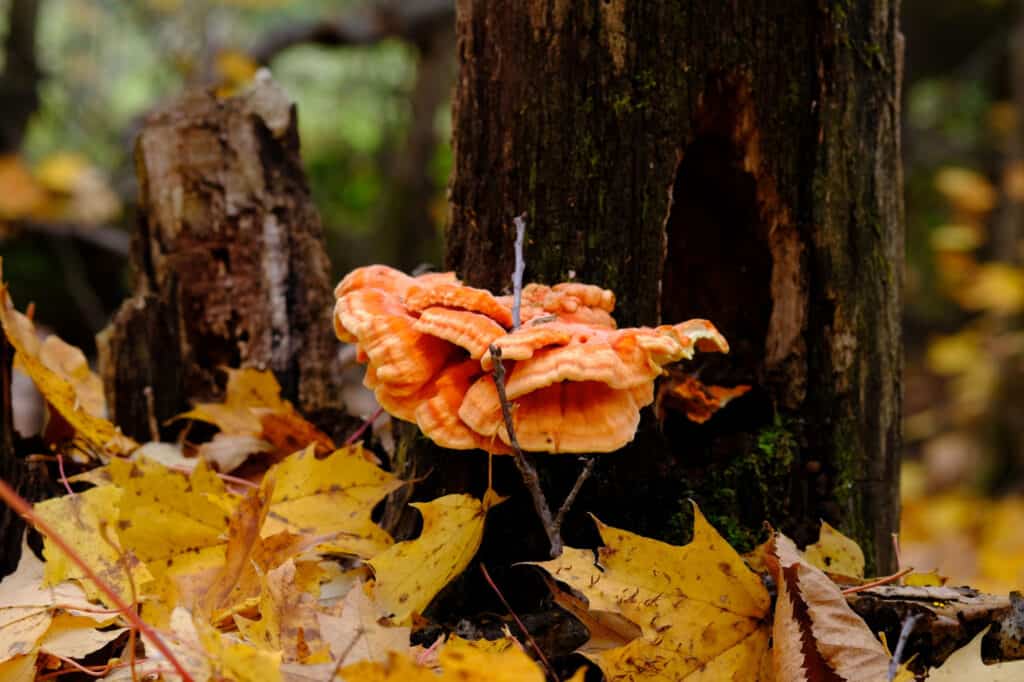
Very few mushroom species look like the chicken of the woods mushroom.
©nomis_h/Shutterstock.com
A wonderful, choice edible orange mushroom, chicken of the woods (Laetiporus sulphureus) is a gorgeous sight to stumble upon in the forest.
Edibility
This edible mushroom is highly sought after by foragers for its meaty texture and savory, nutty, and slightly citrusy taste. As its common name suggests, some folks find the texture and taste of this mushroom to resemble chicken. It’s a wonderful meat substitute and fantastic prepared in a variety of forms. Some folks love to bread and fry them similar to fried chicken or chicken parmesan, while others roast them with garlic, rosemary, and butter.
Please note, some people can experience gastrointestinal discomfort after eating Laetiporus sulphureus. So, make sure to always cook thoroughly, and if it’s your first time eating this species, a safe practice is to only consume a piece about an inch wide and long. Wait 24 hours to see how you feel before eating more.
Research on Potential Medicinal Applications or Properties
While chicken of the woods is most widely known as an excellent edible mushroom, it is also studied for potential medicinal uses. One study used a zebrafish animal model to test for anticancer actions of Laetiporus sulphureus lectin. This study demonstrated effective inhibitory and cytotoxic effects upon cancer cells, with the researchers concluding that lectin from L. sulphureus could be an effective complementary treatment in conjunction with chemotherapy against colorectal carcinoma and melanoma.
Distribution and Ecology
Current genetic sequencing places the distribution of the true Laetiporus sulphureus species throughout regions of hardwood forests and mixed hardwood forests in North America (East of the Rockies), South America, and Europe. Note there are similar-looking species in the Laetiporus genus that may also be referred to as “chicken of the woods”, such as Laetiporus huroniensis.
This mushroom is saprobic and parasitic on its host trees, causing a brown heartwood rot. Brown-rot fungi are able to break down cellulose in wood, but not lignin. They play an essential role in nutrient recycling back into the soil.
To Identify
To find Laetiporus sulphureus, you’ll want to search in hardwood forests from spring through fall, but they are much more common in the fall. This species may be found at the base of standing trees, although it it is more likely to occur on stumps and fallen logs. On standing trees, look for stemless shelf-forming bracket fungi, usually consisting of many dense, brightly colored caps. The entire fruiting body can grow up to 36 inches across, and individual caps, on average, can reach up to 10 inches across.
When these mushrooms are fresh and young (the ideal time for harvesting), they are vividly orange-yellow, but they fade in color as they age. They also become tougher as they age and more difficult to chew. Often, you’ll notice that the overall cap is more of an orange color with a paler or yellow band along the margin. The cap shape can vary from a fairly even semi-circle to fan-shaped, to irregularly wavy.
The spore-bearing tissues of chicken of the woods are vertical, tube-like structures, called pores. For this species, they are bright yellow when young, fading to almost white when very mature. The flesh of this mushroom is pale yellow to white and does not change color upon exposure to air when sliced. The flesh is tender and a bit watery when young, becoming quite tough when mature.
Summary of 3 Types of Orange Mushrooms
Here’s a recap of the three orange mushroom species we took a close look at.
| Number | Mushroom | Scientific Name | Edibility | Distribution |
|---|---|---|---|---|
| 1 | Cinnabar Chanterelle | Cantharellus cinnabarinus | Edible, with an apricot-like, nutty, and floral flavor | North America |
| 2 | Orange Peel Fungus | Aleuria aurantia | Not considered a common edible, but it isn’t toxic and some do eat it | North America, Europe, South America, Asia, and Oceania |
| 3 | Chicken of the Woods Mushroom | Laetiporus sulphureus | Edible and highly prized for its meaty texture and savory, nutty, and citrusy taste | North America, South America, and Europe |
The photo featured at the top of this post is ©
The information presented on or through the Website is made available solely for general informational purposes. We do not warrant the accuracy, completeness, or usefulness of this information. Any reliance you place on such information is strictly at your own risk. We disclaim all liability and responsibility arising from any reliance placed on such materials by you or any other visitor to the Website, or by anyone who may be informed of any of its contents. None of the statements or claims on the Website should be taken as medical advice, health advice, or as confirmation that a plant, fungus, or other item is safe for consumption or will provide any health benefits. Anyone considering the health benefits of particular plant, fungus, or other item should first consult with a doctor or other medical professional. The statements made within this Website have not been evaluated by the Food and Drug Administration. These statements are not intended to diagnose, treat, cure or prevent any disease.
Thank you for reading! Have some feedback for us? Contact the AZ Animals editorial team.



